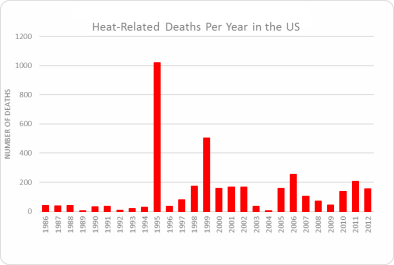Science Source
Heat-Related Deaths during the July 1995 Heat Wave in Chicago
- Seeks to determine who was at greatest risk for heat-related death during the record-setting heat wave in Chicago in July 1995
- Conducts a case–control study in Chicago to identify risk factors associated with heat-related death and death from cardiovascular causes from July 14 through July 17, 1995
- Finds the risk of heat-related death was increased for people with known medical problems who were confined to bed (odds ratio as compared with those who were not confined to bed, 5.5) or who were unable to care for themselves (odds ratio, 4.1)
- Finds that the odds of death also increased for those who did not leave home each day (odds ratio, 6.7), who lived alone (odds ratio, 2.3), or who lived on the top floor of a building (odds ratio, 4.7)
- Finds, using a multivariate analysis, that the strongest risk factors for heat-related death were being confined to bed (odds ratio, 8.2) and living alone (odds ratio, 2.3); the risk of death was reduced for people with working air conditioners (odds ratio, 0.3) and those with access to transportation (odds ratio, 0.3). Deaths classified as due to cardiovascular causes had risk factors similar to those for heat-related death
- Summarizes findings stating that those at greatest risk of dying from the heat were people with medical illnesses who were socially isolated and did not have access to air conditioning
Related Content
Headline

Apr 1, 2016 | Illinois State Climatologist Office
Heat-Related Deaths in the US
Science Source
| Annals of Internal Medicine
Near-Fatal Heat Stroke during the 1995 Heat Wave in Chicago
Jane E. Dematte, Karen O'Mara, Jennifer Buescher et al
Headline

Apr 1, 2016 | Chicago Magazine
How 739 People Died in a Chicago Heat Wave
Science Source
| PubMed - NCBI
Heat waves in the United States: mortality risk during heat waves and effect modification by heat wave characteristics in 43 U.S. communities
Anderson GB and Bell ML


